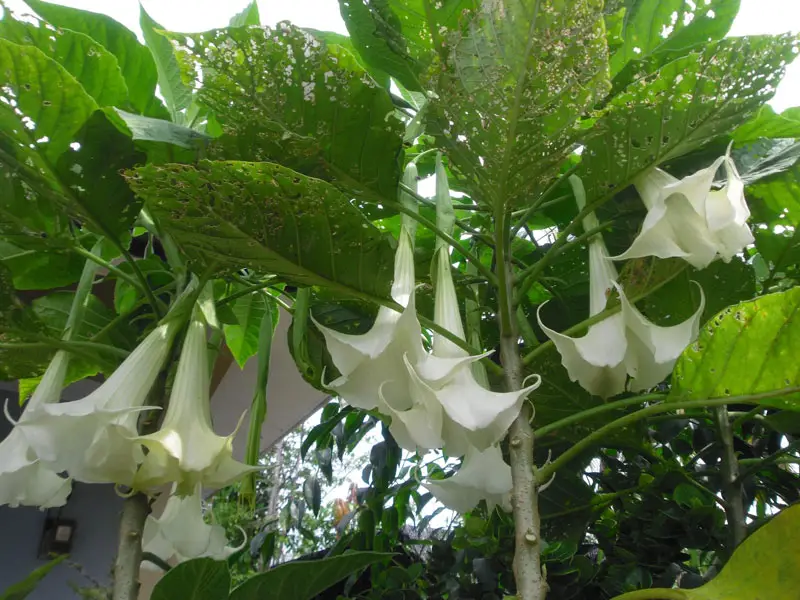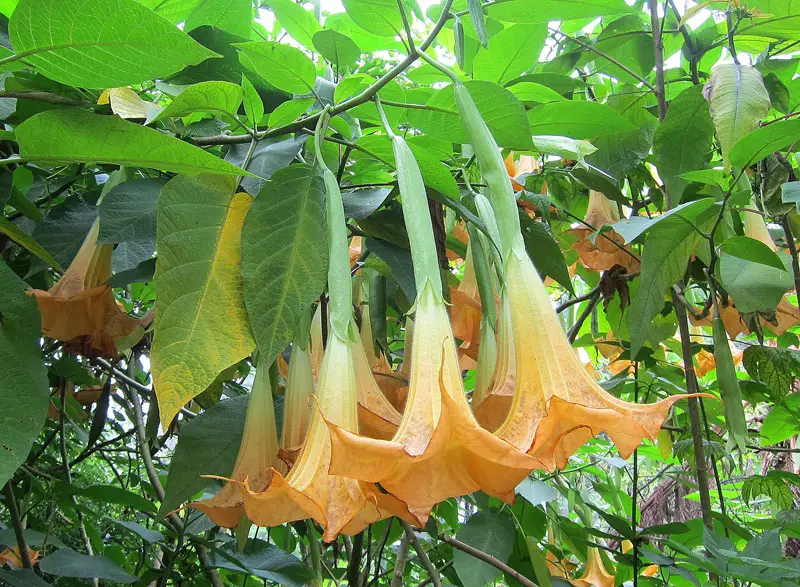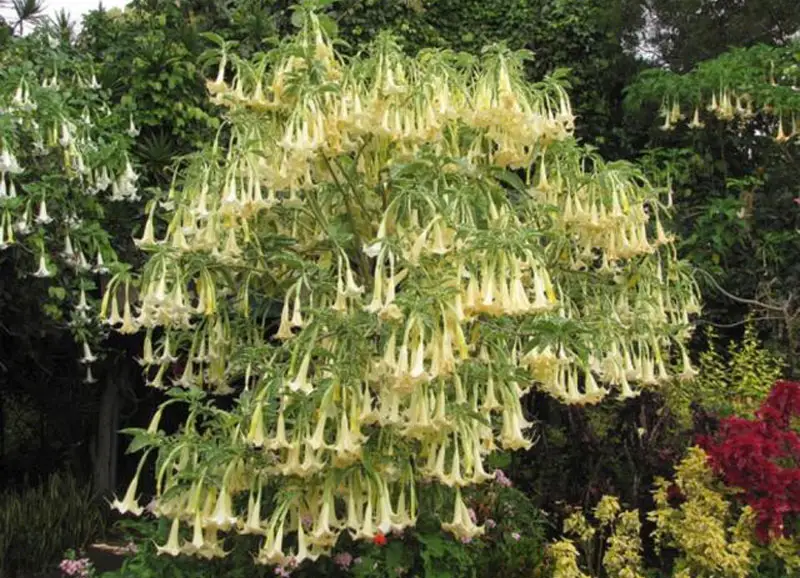I believe that no flower is more imposing than the Angel Trumpet Plant.
The tube-shaped flowers that fully blossom on the tree can be amazing no matter how you view them from different angles.
Maybe it realized that its personality was too flamboyant, and when the flower bloomed, it actually grew upside down.
Why do its flowers grow upside down? Let’s take a look at this beautiful, but “untouchable” plant.
Common names: Angel Trumpet Plant, Brugmansia, Angel-star
The Angel Trumpet Plant or scientifically known as Brugmansia Suaveolens is a small plant with shrub-like qualities.
Many branches emanate from its central trunk. The shapes of the leaves are like almonds, about ten inches in length and almost six inches in diameter.
Many larger specimens have been found when in the shade. Overall, it has its rough edges, but its crowning glory is its fragrant flower.
The flowers, shaped like trumpets, grow in lengths of up to a foot long. Called the corella, it has five points that curve upwards near the tips. Colors range from white to Yellow and are known to be nodding downwards from the branches of the plant. They are grouped under the Solanaceae genus, where potatoes and tomatoes are also included.
Description:
The other kind of trumpet Plant has double flowers instead. It appears like a smaller trumpet within a larger one. Another strain, a unique hybrid, possesses large flowers, some up to over fifteen inches long.
These are shaped like bells with hues ranging from the bright yellows to the dainty pinks. This hybrid, called the B. X insignis is known to bloom all year round.
Plant Location:
Many of these trumpet flowers bloom naturally in the tropical rainforests of Brazil. It is often used to decorate a home and their hardy nature has allowed them to flourish not only in the Americas but also crossed over to Florida. The angel trumpet plant can be grown outdoors as well.
The Plant grows best outdoors and in the sun. When placed under the shade, it may impede its natural growth pattern. It also requires regular moisture, owing to its rainforest roots. But it can survive droughts.
This being a soft wooded shrub, it dies and re-blooms every winter and spring.
In these conditions, the tree grows no more than eight feet tall. It is not able to recuperate after several winters and dies after a few springs.
These plants are usually grown from seeds. However, they can also be grown as saplings or cuttings and immediately planted. It can also be pruned into a small tree or allowed to flourish as several shrubs together.
The Angel Trumpet Plant has grown in popularity as a lawn plant in the US and other countries. They can be used with other shrubs to border property or be the centerpiece of a plant ensemble.
It is also important to have these plants for night gardens as the fragrance wafts through the garden in the evenings and the lowers close up when the first rays of light hit them.
The beauty of an Angel Trumpet Plant heavy with Blooming Flowers makes for a treat both for the eyes and the nose. And with the proper attention, they can propagate their beauty all year round.
Landscape Usage:
As South American citizens of the plant world, these flowering Angel Trumpet plants prefer the moisture soaked of the forest in the heat of days and the coolness of nights. But beware for this beauty is dangerous.
Keeping it healthy, once you have decided to grow them, is your first concern. Rather than creating a phalanx of trees, it would be best to turn your attention to a single shrub and make it bloom.
Water is essential to the plant’s growth and the pot must be able to handle large quantities of water and can handle flooding the roots with the daily introduction of water.
Pros:
The Plant It is a tropical rainforest species able to thrive in conditions other flowering plants cannot live on. Also, the tree can be made a centerpiece of a garden ensemble to enamor the hard-core horticulturist in the area.
Cons:
There is much literature on the subject and these can be found online or in your horticulturist clubs or stores. What cannot be ascertained is the poisonous content of the Angel trumpet flowers.
The poison is concentrated in the seedpod and the proper way to handle them is to avoid direct contact. Over time though, the flower would bloom into the beauty that it is despite its dangerous nature.
In the wild, the seed extracts of the Angel Trumpet Plant are a favored toxin among indigenous folk in South America. It is important that if you have children or guests that the proper appreciation of the flower pod is provided to avoid unnecessary and often avoidable ingestion of the poisons of the plant.
Angel Trumpets Plant Facts
The plant flowers open after sunset and stay open until sunrise the next morning.
If you provide proper care the plants will bloom year-round.
The Angel Trumpet plant prefers damp conditions, warm days, and mildly cool nights.
The plants are included in the Solanaceae family, the same family that tomatoes and potatoes are members of.
To achieve maximum blooms from the plant, fertilizer it every three to four weeks.
If grown outdoors in the ground, zone 9 is where the plant will do best.
Frequent pruning of the angel trumpet plant will force the plant to grow more limbs and produce more flowers.
Propagation Techniques for the Angel Trumpet Plant: Starting new plants from cuttings is easy. Just dip them into quality rooting hormone and place them out of the direct sun. Spray the leaves frequently to keep them moist.
A Highly Toxic Plant: The Angel Trumpets have been used as a hallucinogenic drug, which has caused many deaths. Consider NOT growing this plant if you have children or pets. Some people are wondering whether the plant can also be poisoned by simply smell on the flower? Well, smelling the flower will not be poisoned, as long as you don’t eat its leaves, branches, and roots, and you are safe. Nonetheless, do try not to smell it for too long.
What To Do If Poisoned by Angel Trumpet Plants
As Angel Trumpet Plant is poisonous, you should avoid consuming them at all. What is going to happen if you accidentally consume angel trumpets? You may result in an alkaloid-induced central nervous system. This may cause agitation, fever, delirium, memory disturbance, and other illness to a person. If seriously poisonous, it may even cause death.
How to Treat It?
If you accidentally ingest Angel Trumpets, the quickest way is to induce vomiting and go to the hospital for gastric lavage as soon as possible after inducing vomiting.
Gastric lavage with potassium permanganate solution or tannic acid should be used immediately. And then magnesium oxide, charcoal powder, or general antidote should be taken orally.
You can also consume salt laxatives, and glucose solution should be injected intravenously at the same time to promote the discharge of poisons.
Poison-eating Butterflies
In Brazil where the plant is originated, there is a kind of butterfly that eats the Angel Trumpet Plants!
The Latin name of this butterfly is “Placidina euryanassa”. They can feed on the leaves of the Angel Trumpet Plant while they’re in larval form. They can also store the alkaloids in the body. Once pupated, they can use the toxins to defend themselves.
Therefore, it seems that this plant also has not escaped the rule of nature where there is still a predator for the plant even they are poisonous.



